-
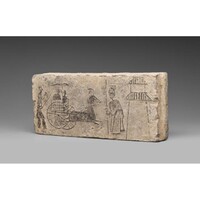 Tomb brick
Tomb brick This is a brick that is from a Han tomb of the Eastern Han period. The sketch depicts a chariot, a driver, a horse, another man and a tower. Above the drivers head is an umbrella. The umbrella signifies that the driver is a noble man. The chariot is approaching the man at the front of the tower. In Chinese the tower is called a que.
-
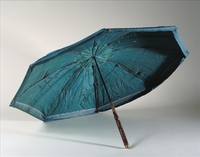 Umbrella System Marius
Umbrella System Marius This is a folding rain umbrella. It has eight metal branches that make the frame which is made of metal and it is covered in green silk canvas. It has a telescopic iron rod mast. The handle has an oak finish.
-
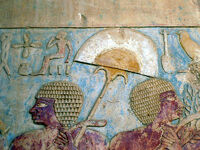 File:Hatshepsut temple4 b.jpg
File:Hatshepsut temple4 b.jpg This images in from the Hatshepsut temple in Egypt. The engraving in the wall depicts
-
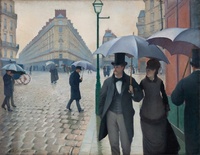 Paris Street; Rainy Day
Paris Street; Rainy Day This is a painting by the French artist Gustave Caillebotte. The painting depicts men and women walking in the streets of Paris on a rainy day. In this image men are holding umbrellas. The men are wearing tall hats and bow ties. The woman in the image is also wearing a hat. All the people are wearing coats. In the distance there are tall building and the street is made of pavers.
-
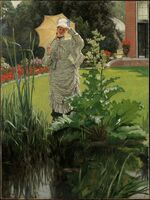 Spring Morning
Spring Morning This is an oil painting painted by French artist James Tissot in 1875. The painting depicts a woman in a garden. She is standing in green grass and is surrounded by green, red, pink, and white plants. She is wearing white and green dress with a matching jacket. She is wearing a hat and carrying a cream colored parasol. She is hold her left arm up with her had above her eyes looking in the distance.
-
 Doreen Duran
Doreen Duran A self portrait taken by iPhone camera of Doreen Duran.
-
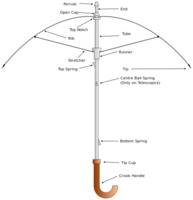 Parts of an umbrella.
Parts of an umbrella. This pictures is a diagram of an umbrella. The diagram points out all of the parts of an umbrella with a name label. Beginning from the top of the umbrella is the ferrule, the end, and the open cap. The umbrella portion, where the fabric would be, consists of the top notch, the tube, and the ribs and tips with a runner and a stretcher. The top and bottom springs will open and close the umbrella. At the handle there is the tip cup and the crook handle.
-
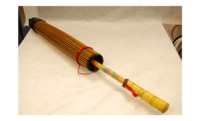 Parasol
Parasol This parasol was made in Burma. It was used by monks. It has a scarlet guard that keeps the parasol closed tight. It is made of oiled cloth that is sewn on a bamboo frame and a lacquered cloth with an internal net of colored threads. This parasol was excavated by T Richard Blurton.
-
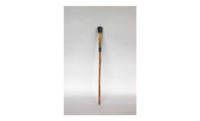 Parasol Handle
Parasol Handle This is a parasol handle and shaft. The shaft is made out of wood. It is believed to have come from Africa or India and mounted in England. The shaft has a metal spring which was used to open and close the frame. The handle is ivory and carved with a twisted wreath pattern. The tips are mounted in silver and engraved with foliate motifs. The handle is engraved with the letters WMN.
-
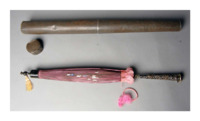 parasol; container; lid
parasol; container; lid Parasol from Southeast Asia, made in Burma. It is from before World War II and it served throughout the war with Burmese and Karen forces, and the ‘chindits’.This parasol features a dented container with a lid. The parasol has a tassel on the Ferrule tip with an engraved handle and a ring for closure. The materials are unknown.
-
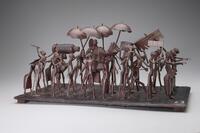 Depiction of a Ceremonial Procession
Depiction of a Ceremonial Procession This is a Fon brass tableaux . The sculpture depicts about eighteen people which are holding weapons, they are in a procession surrounding one man who is on a horse. Four of the people are carrying umbrellas over the head of the man.
-
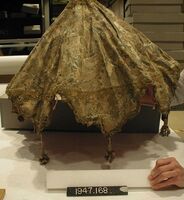 Umbrella
Umbrella This umbrella is from Italy. It is a venetian umbrella from the 17th century. The material is brocaded lace. The handle and ferrule tip are unknown.
-
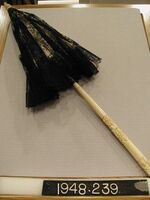 Carriage Parasol
Carriage Parasol Parasol made in France from the 19th century. It is made in black Chantilly lace.
-
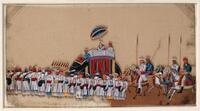 A high ranking man sitting under a parasol on an elephant, preceded by a group of soldiers on foot and followed by four soldiers on horseback.
A high ranking man sitting under a parasol on an elephant, preceded by a group of soldiers on foot and followed by four soldiers on horseback. This is a painting on mica by an unknown Indian artist. The painting depicts a man sitting on an elephant. He is accompanied by his parasol bearer. The parasol bearer is holding blue parsol with gold fringe. The man is preceded by a group of soldiers on foot and he is followed by four soldiers with spears and they are sitting on horses
-
 Tutankhamun Fan
Tutankhamun Fan This fan was found in the burial chamber of Tutankhamun. It was located between the two innermost shrines. The fan is wood and is covered with sheet gold. Tutankhamun hunted ostriches which is why his fan was fitted with white and brown ostrich feathers. Stumps of the feathers may still be seen in the holes on the outer edge of the palm.
-
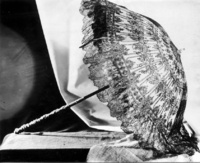 Parasol
Parasol This is a parasol made in France. It is made of black Chantilly lace over white surah and lined with thin black silk. The handle is made of ivory and carved with design of grapes and leaves. The frame is made of steel and black enamel tubing with a modern fastening.
-
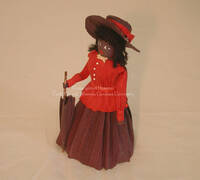 Cornhusk doll: African Americal
Cornhusk doll: African Americal This is a doll made of cornhusk. The doll was made by Frances Nicholson of Jackson County, N.C. in the 1940s. The doll is made in the form of an African-American woman dressed in a purple skirt, red top. She is wearing a purple hat and holding a purple umbrella.
-
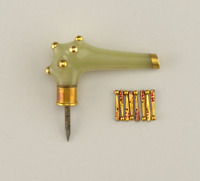 Jade Umbrella Handle
Jade Umbrella Handle This is a Jade and gold umbrella handle and Pins.
-
 Mary Poppins Flying Nanny Scene
Mary Poppins Flying Nanny Scene This is a video clip from the 1964 movie, Mary Poppins of the Flying Nanny. This scene is when the family is going to hire a nanny for the two children. The house shakes when the clock chimes. The two children are at the upstairs window peering out at all of the nannies waiting for an interview. Then it gets very windy and all of the nannies umbrellas begin to open and they are all blown away by the wind. The the children see in the far distance, in the air Mary Poppins who flies in. The children are talking to each other and this is when they know that this is the woman that will be their nanny.
-
 Singing in The Rain Scene from the film Singing in The Rain with Gene Kelly
Singing in The Rain Scene from the film Singing in The Rain with Gene Kelly Don Lockwood's (Gene Kelly) love for Kathy causes him to smile, walk, and sing in the rain. He is wearing a gray suit and he close his umbrella and begins walking and singing the song "Singing in the Rain". He is walking, dancing, and twirling his umbrella.
-
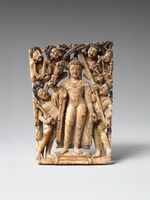 Panel from a Portable Shrine: The Descent of the Buddha from Trayastrimsha Heaven
Panel from a Portable Shrine: The Descent of the Buddha from Trayastrimsha Heaven This object is made of ivory, standing 2 1/2 x 1 3/4 inches. The small statue depicts Buddha descending from Trayastrimsha heaven. Buddha is standing on three steps which indicates the ladder upon which he descended. Buddha is surrounded by umbrella, flywhisk, and garland bearers.
-
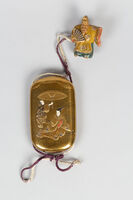 Case (Inrō) with Design of Seated Courtier beneath Umbrella (obverse) Noh Dancer (reverse)
Case (Inrō) with Design of Seated Courtier beneath Umbrella (obverse) Noh Dancer (reverse) This is a Japanese 19th century gold lacquer case. The design on the front of the case is of a courtier holding a red fan, and he is seated beneath an umbrella that is held by a Japanese Noh dancer. There are two ties on the case and at the end is a small charm with a man in a yellow kimono wearing green pants, a hat, and he is holding a fan.
-
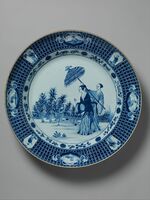 Plate depicting a lady with parasol
Plate depicting a lady with parasol This is a blue and white Chinese Dutch Market plate and depictc a lady with a parasol. The company that manufactured this design commissioned the artist Cornelis Pronk. The company was able to copy the design onto the porcelain plates and export them. This lady with parasol design was one of Pronk's most popular compositions.
-
 Parasol
Parasol This is a Parasol made in France. The fabric is burgundy silk, and it has an embellished ferrule tip and a wood handle.
-
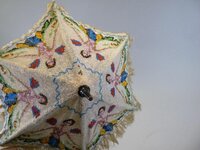 Parasol
Parasol This parasol was made in Italy. It is a small parasol with a fully beaded cover in blue, cream, red, and yellow depicting a twin-tailed mermaid or siren. The cover is edged with a silk fringe and lined with white silk covering the internal structure. The pole and handle are wood, with a metal ferrule and is has a ring-shaped nose cap, which might allow it to be worn on the finger or attached to a waist belt.
 Tomb brick This is a brick that is from a Han tomb of the Eastern Han period. The sketch depicts a chariot, a driver, a horse, another man and a tower. Above the drivers head is an umbrella. The umbrella signifies that the driver is a noble man. The chariot is approaching the man at the front of the tower. In Chinese the tower is called a que.
Tomb brick This is a brick that is from a Han tomb of the Eastern Han period. The sketch depicts a chariot, a driver, a horse, another man and a tower. Above the drivers head is an umbrella. The umbrella signifies that the driver is a noble man. The chariot is approaching the man at the front of the tower. In Chinese the tower is called a que. Umbrella System Marius This is a folding rain umbrella. It has eight metal branches that make the frame which is made of metal and it is covered in green silk canvas. It has a telescopic iron rod mast. The handle has an oak finish.
Umbrella System Marius This is a folding rain umbrella. It has eight metal branches that make the frame which is made of metal and it is covered in green silk canvas. It has a telescopic iron rod mast. The handle has an oak finish. File:Hatshepsut temple4 b.jpg This images in from the Hatshepsut temple in Egypt. The engraving in the wall depicts
File:Hatshepsut temple4 b.jpg This images in from the Hatshepsut temple in Egypt. The engraving in the wall depicts Paris Street; Rainy Day This is a painting by the French artist Gustave Caillebotte. The painting depicts men and women walking in the streets of Paris on a rainy day. In this image men are holding umbrellas. The men are wearing tall hats and bow ties. The woman in the image is also wearing a hat. All the people are wearing coats. In the distance there are tall building and the street is made of pavers.
Paris Street; Rainy Day This is a painting by the French artist Gustave Caillebotte. The painting depicts men and women walking in the streets of Paris on a rainy day. In this image men are holding umbrellas. The men are wearing tall hats and bow ties. The woman in the image is also wearing a hat. All the people are wearing coats. In the distance there are tall building and the street is made of pavers. Spring Morning This is an oil painting painted by French artist James Tissot in 1875. The painting depicts a woman in a garden. She is standing in green grass and is surrounded by green, red, pink, and white plants. She is wearing white and green dress with a matching jacket. She is wearing a hat and carrying a cream colored parasol. She is hold her left arm up with her had above her eyes looking in the distance.
Spring Morning This is an oil painting painted by French artist James Tissot in 1875. The painting depicts a woman in a garden. She is standing in green grass and is surrounded by green, red, pink, and white plants. She is wearing white and green dress with a matching jacket. She is wearing a hat and carrying a cream colored parasol. She is hold her left arm up with her had above her eyes looking in the distance. Doreen Duran A self portrait taken by iPhone camera of Doreen Duran.
Doreen Duran A self portrait taken by iPhone camera of Doreen Duran. Parts of an umbrella. This pictures is a diagram of an umbrella. The diagram points out all of the parts of an umbrella with a name label. Beginning from the top of the umbrella is the ferrule, the end, and the open cap. The umbrella portion, where the fabric would be, consists of the top notch, the tube, and the ribs and tips with a runner and a stretcher. The top and bottom springs will open and close the umbrella. At the handle there is the tip cup and the crook handle.
Parts of an umbrella. This pictures is a diagram of an umbrella. The diagram points out all of the parts of an umbrella with a name label. Beginning from the top of the umbrella is the ferrule, the end, and the open cap. The umbrella portion, where the fabric would be, consists of the top notch, the tube, and the ribs and tips with a runner and a stretcher. The top and bottom springs will open and close the umbrella. At the handle there is the tip cup and the crook handle. Parasol This parasol was made in Burma. It was used by monks. It has a scarlet guard that keeps the parasol closed tight. It is made of oiled cloth that is sewn on a bamboo frame and a lacquered cloth with an internal net of colored threads. This parasol was excavated by T Richard Blurton.
Parasol This parasol was made in Burma. It was used by monks. It has a scarlet guard that keeps the parasol closed tight. It is made of oiled cloth that is sewn on a bamboo frame and a lacquered cloth with an internal net of colored threads. This parasol was excavated by T Richard Blurton. Parasol Handle This is a parasol handle and shaft. The shaft is made out of wood. It is believed to have come from Africa or India and mounted in England. The shaft has a metal spring which was used to open and close the frame. The handle is ivory and carved with a twisted wreath pattern. The tips are mounted in silver and engraved with foliate motifs. The handle is engraved with the letters WMN.
Parasol Handle This is a parasol handle and shaft. The shaft is made out of wood. It is believed to have come from Africa or India and mounted in England. The shaft has a metal spring which was used to open and close the frame. The handle is ivory and carved with a twisted wreath pattern. The tips are mounted in silver and engraved with foliate motifs. The handle is engraved with the letters WMN. parasol; container; lid Parasol from Southeast Asia, made in Burma. It is from before World War II and it served throughout the war with Burmese and Karen forces, and the ‘chindits’.This parasol features a dented container with a lid. The parasol has a tassel on the Ferrule tip with an engraved handle and a ring for closure. The materials are unknown.
parasol; container; lid Parasol from Southeast Asia, made in Burma. It is from before World War II and it served throughout the war with Burmese and Karen forces, and the ‘chindits’.This parasol features a dented container with a lid. The parasol has a tassel on the Ferrule tip with an engraved handle and a ring for closure. The materials are unknown. Depiction of a Ceremonial Procession This is a Fon brass tableaux . The sculpture depicts about eighteen people which are holding weapons, they are in a procession surrounding one man who is on a horse. Four of the people are carrying umbrellas over the head of the man.
Depiction of a Ceremonial Procession This is a Fon brass tableaux . The sculpture depicts about eighteen people which are holding weapons, they are in a procession surrounding one man who is on a horse. Four of the people are carrying umbrellas over the head of the man. Umbrella This umbrella is from Italy. It is a venetian umbrella from the 17th century. The material is brocaded lace. The handle and ferrule tip are unknown.
Umbrella This umbrella is from Italy. It is a venetian umbrella from the 17th century. The material is brocaded lace. The handle and ferrule tip are unknown. Carriage Parasol Parasol made in France from the 19th century. It is made in black Chantilly lace.
Carriage Parasol Parasol made in France from the 19th century. It is made in black Chantilly lace. A high ranking man sitting under a parasol on an elephant, preceded by a group of soldiers on foot and followed by four soldiers on horseback. This is a painting on mica by an unknown Indian artist. The painting depicts a man sitting on an elephant. He is accompanied by his parasol bearer. The parasol bearer is holding blue parsol with gold fringe. The man is preceded by a group of soldiers on foot and he is followed by four soldiers with spears and they are sitting on horses
A high ranking man sitting under a parasol on an elephant, preceded by a group of soldiers on foot and followed by four soldiers on horseback. This is a painting on mica by an unknown Indian artist. The painting depicts a man sitting on an elephant. He is accompanied by his parasol bearer. The parasol bearer is holding blue parsol with gold fringe. The man is preceded by a group of soldiers on foot and he is followed by four soldiers with spears and they are sitting on horses Tutankhamun Fan This fan was found in the burial chamber of Tutankhamun. It was located between the two innermost shrines. The fan is wood and is covered with sheet gold. Tutankhamun hunted ostriches which is why his fan was fitted with white and brown ostrich feathers. Stumps of the feathers may still be seen in the holes on the outer edge of the palm.
Tutankhamun Fan This fan was found in the burial chamber of Tutankhamun. It was located between the two innermost shrines. The fan is wood and is covered with sheet gold. Tutankhamun hunted ostriches which is why his fan was fitted with white and brown ostrich feathers. Stumps of the feathers may still be seen in the holes on the outer edge of the palm. Parasol This is a parasol made in France. It is made of black Chantilly lace over white surah and lined with thin black silk. The handle is made of ivory and carved with design of grapes and leaves. The frame is made of steel and black enamel tubing with a modern fastening.
Parasol This is a parasol made in France. It is made of black Chantilly lace over white surah and lined with thin black silk. The handle is made of ivory and carved with design of grapes and leaves. The frame is made of steel and black enamel tubing with a modern fastening. Cornhusk doll: African Americal This is a doll made of cornhusk. The doll was made by Frances Nicholson of Jackson County, N.C. in the 1940s. The doll is made in the form of an African-American woman dressed in a purple skirt, red top. She is wearing a purple hat and holding a purple umbrella.
Cornhusk doll: African Americal This is a doll made of cornhusk. The doll was made by Frances Nicholson of Jackson County, N.C. in the 1940s. The doll is made in the form of an African-American woman dressed in a purple skirt, red top. She is wearing a purple hat and holding a purple umbrella. Jade Umbrella Handle This is a Jade and gold umbrella handle and Pins.
Jade Umbrella Handle This is a Jade and gold umbrella handle and Pins. Mary Poppins Flying Nanny Scene This is a video clip from the 1964 movie, Mary Poppins of the Flying Nanny. This scene is when the family is going to hire a nanny for the two children. The house shakes when the clock chimes. The two children are at the upstairs window peering out at all of the nannies waiting for an interview. Then it gets very windy and all of the nannies umbrellas begin to open and they are all blown away by the wind. The the children see in the far distance, in the air Mary Poppins who flies in. The children are talking to each other and this is when they know that this is the woman that will be their nanny.
Mary Poppins Flying Nanny Scene This is a video clip from the 1964 movie, Mary Poppins of the Flying Nanny. This scene is when the family is going to hire a nanny for the two children. The house shakes when the clock chimes. The two children are at the upstairs window peering out at all of the nannies waiting for an interview. Then it gets very windy and all of the nannies umbrellas begin to open and they are all blown away by the wind. The the children see in the far distance, in the air Mary Poppins who flies in. The children are talking to each other and this is when they know that this is the woman that will be their nanny. Singing in The Rain Scene from the film Singing in The Rain with Gene Kelly Don Lockwood's (Gene Kelly) love for Kathy causes him to smile, walk, and sing in the rain. He is wearing a gray suit and he close his umbrella and begins walking and singing the song "Singing in the Rain". He is walking, dancing, and twirling his umbrella.
Singing in The Rain Scene from the film Singing in The Rain with Gene Kelly Don Lockwood's (Gene Kelly) love for Kathy causes him to smile, walk, and sing in the rain. He is wearing a gray suit and he close his umbrella and begins walking and singing the song "Singing in the Rain". He is walking, dancing, and twirling his umbrella. Panel from a Portable Shrine: The Descent of the Buddha from Trayastrimsha Heaven This object is made of ivory, standing 2 1/2 x 1 3/4 inches. The small statue depicts Buddha descending from Trayastrimsha heaven. Buddha is standing on three steps which indicates the ladder upon which he descended. Buddha is surrounded by umbrella, flywhisk, and garland bearers.
Panel from a Portable Shrine: The Descent of the Buddha from Trayastrimsha Heaven This object is made of ivory, standing 2 1/2 x 1 3/4 inches. The small statue depicts Buddha descending from Trayastrimsha heaven. Buddha is standing on three steps which indicates the ladder upon which he descended. Buddha is surrounded by umbrella, flywhisk, and garland bearers. Case (Inrō) with Design of Seated Courtier beneath Umbrella (obverse) Noh Dancer (reverse) This is a Japanese 19th century gold lacquer case. The design on the front of the case is of a courtier holding a red fan, and he is seated beneath an umbrella that is held by a Japanese Noh dancer. There are two ties on the case and at the end is a small charm with a man in a yellow kimono wearing green pants, a hat, and he is holding a fan.
Case (Inrō) with Design of Seated Courtier beneath Umbrella (obverse) Noh Dancer (reverse) This is a Japanese 19th century gold lacquer case. The design on the front of the case is of a courtier holding a red fan, and he is seated beneath an umbrella that is held by a Japanese Noh dancer. There are two ties on the case and at the end is a small charm with a man in a yellow kimono wearing green pants, a hat, and he is holding a fan. Plate depicting a lady with parasol This is a blue and white Chinese Dutch Market plate and depictc a lady with a parasol. The company that manufactured this design commissioned the artist Cornelis Pronk. The company was able to copy the design onto the porcelain plates and export them. This lady with parasol design was one of Pronk's most popular compositions.
Plate depicting a lady with parasol This is a blue and white Chinese Dutch Market plate and depictc a lady with a parasol. The company that manufactured this design commissioned the artist Cornelis Pronk. The company was able to copy the design onto the porcelain plates and export them. This lady with parasol design was one of Pronk's most popular compositions. Parasol This is a Parasol made in France. The fabric is burgundy silk, and it has an embellished ferrule tip and a wood handle.
Parasol This is a Parasol made in France. The fabric is burgundy silk, and it has an embellished ferrule tip and a wood handle. Parasol This parasol was made in Italy. It is a small parasol with a fully beaded cover in blue, cream, red, and yellow depicting a twin-tailed mermaid or siren. The cover is edged with a silk fringe and lined with white silk covering the internal structure. The pole and handle are wood, with a metal ferrule and is has a ring-shaped nose cap, which might allow it to be worn on the finger or attached to a waist belt.
Parasol This parasol was made in Italy. It is a small parasol with a fully beaded cover in blue, cream, red, and yellow depicting a twin-tailed mermaid or siren. The cover is edged with a silk fringe and lined with white silk covering the internal structure. The pole and handle are wood, with a metal ferrule and is has a ring-shaped nose cap, which might allow it to be worn on the finger or attached to a waist belt.